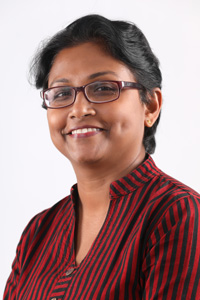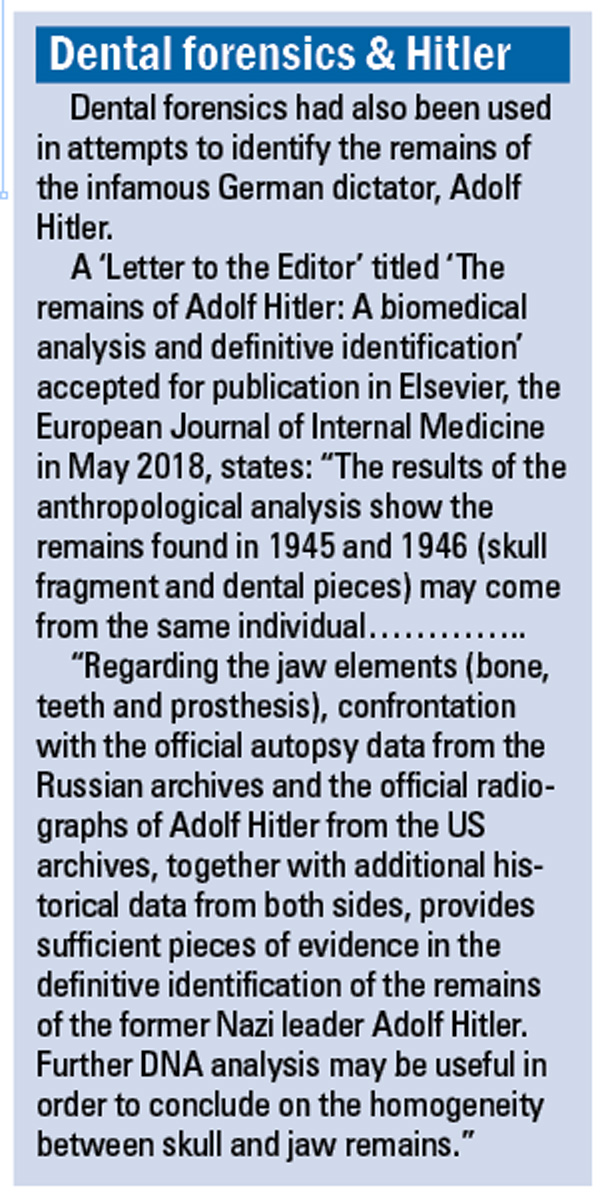News
Giving teeth to accurate identification
Sending back the right person to his or her loved ones is what she does using her skill and expertise, which is all to do with teeth.

Dr. Jayanie Weeratna
Before detailing what this field which is relatively new to Sri Lanka is about, Forensic Odontologist Dr. Jayanie Weeratna tells the Sunday Times that she fulfilled her duty by sending the badly-burnt remains of the four Air Force personnel in the tragic Haputale aircraft crash on January 3 to their own loved ones.
“The Air Force keeps meticulous dental records of its personnel and this enabled me to identify the different personnel in that crash with 100% accuracy,” says Dr. Weeratna who is attached to the Institute of Forensic Medicine & Toxicology (formerly the Office of the Colombo Judicial Medical Officer), Colombo.
What came to her aid was ‘forensic odontology’ or forensic dentistry carried out using dental records – one who had succumbed had two impacted teeth, another had a fracture and the other two had undergone different treatment for dental issues. All these were used in the identification. Here post-mortem (after death) dental records were compared with ante-mortem (before death) dental records.
Even though the specialized field of forensic odontology has been around for a long time at a few institutions across the world – the Victorian Institute of Forensic Medicine in Melbourne, Australia, and in a couple of Scandinavian countries – it is relatively new in Sri Lanka. Most experts in forensic odontology are attached to universities and hardly to institutions as service providers, the Sunday Times understands.
In Sri Lanka, the service component of forensic odontology is effectively provided by the Institute of Forensic Medicine & Toxicology, while qualified dentists can handle age assessments through this science but not medico-legal investigations, it is understood.
Pointing out in simple terms that in the application of forensics in dentistry, “we use basic dental knowledge to solve medico-legal issues”, Dr. Weeratna turns towards the United Kingdom where in days gone by photographs of peculiarities of the teeth were published in dental journals when unidentified persons were found. “Now it has become a science.”
The international standards for foolproof methods of identification are DNA (genetic) testing, fingerprinting and dental data, the Sunday Times learns. The other methods include visual identification and the presence of medical prostheses.
“DNA testing is expensive and lengthy and it may not be possible to collect DNA samples in every instance. Fingerprinting would be valid only in a case where the unique print of a person on record has not got defaced so that comparison with the owner’s fingerprint is possible. Another factor is that the person’s fingerprints would have to be stored somewhere,” she says.
Explaining that no two individuals have the same dentition, not even identical twins, even though the number of teeth may be the same, Dr. Weeratna says the arrangement and shape of the teeth will be different. “Even in twins, there will be unique disease conditions and filled cavities etc………if there is the same filling on the same tooth surface, using the same material, yet the fillings will be tailor-made for that person. So we can compare pictures or radiography material of a person with that of someone who is deceased.”
Forensic odontology is easy to use for identification as most people have ante-mortem reports, she says, making a strong case for teeth which are the strongest tissue in the body and can resist temperatures of 1,000C. They are also the last to disintegrate, much after even the long bones have dissolved.

The dental team at work in the mortuary after the Easter Sunday bombings in April 2019
This is why an earnest request goes out from her to dental surgeons to maintain good records of the patients they see. These will be useful in clinical management and forensics, like in the case of the Air Force maintaining these records.
Taking up disasters and how they group them, Dr. Weeratna says they would be “small, medium or big” and “open, closed or mixed”. The tsunami of 2004 was a big, open natural disaster; the 9/11 US Twin Tower man-made disaster was a big, mixed one; and the Haputale aircraft crash was a small, closed disaster.
9/11 was a mixed disaster because the names of the passengers on the plane which crashed into the Twin Towers were known but not those who succumbed in the Twin Towers. Usually, a plane crash would be a closed disaster as even though many would have died, their names would be known. Then what is needed is identification of whose remains they are, it is understood.
Recalling the tragic day on which they were informed about the Haputale crash, Dr. Weeratna says they knew there were four personnel, they knew their names and were also able to secure their ante-mortem dental records.
“When I went to the mortuary to look at the remains on the table that day I had already made four files and compiled the ante-mortem information sheets. The remains were badly burnt but the teeth were intact and I identified the personnel within half an hour,” she says, going back to the 2014 plane crash in Athurugiriya, where they used the same technique to identify the five casualties. Four had died on the spot and one person later. One had been badly burnt and the others badly mutilated.
With regard to the Easter Sunday bomb blasts of April 2019, she says how all the Sri Lankan victims were identified by way of personal belongings, except one. This female was identified using a selfie she had taken earlier which indicated a rotated tooth and even though she had been decapitated, her identification was possible through her teeth.
A Forensic Odontologist can also determine whether the remains are of a male or female.
When identifying the 42 foreigners who had succumbed, the personal belongings of the Indian casualties helped identify them, but for the British, Interpol sought one of the three international standards of identification and that was dental forensics………and so this was the scientific identification carried out not only for 9 Britons but also for 2 British/American citizens and 2 Swedes.
Dental data play a major role in huge disasters, Dr. Weeratna reiterates, and many foreigners who died in the tsunami in Thailand were identified through this technique.
Some of the examples include the October 2002 Bali bombings in the tourist district of Kuta, Indonesia where 202 people were killed; the February 2009 Victorian bushfires in Australia where 173 people are believed to have died; and the Malaysia Airlines Flight 17 from Amsterdam to Kuala Lumpur that was shot down in July 2014 while flying over eastern Ukraine in which all 283 passengers and 15 crew were killed.
The other areas in which forensic odontology is crucial are injury assessment where a JMO has to see the degree of damage/harm done to a victim for criminal or civil purposes – if teeth are broken in an accident, if there is a need for surgery and there has been disfigurement.
| Dental ID, bite-marks and age assessment | |
| Forensic odontology is useful in three important areas: · Dental identification – This is conducted in situations where the identity of the dead is not known. People’s dental structures do not change and this is a good tool, especially in a disaster, where the victims may be disfigured, burned, putrefied, badly skeletonized or traumatized, says Dr. Jayanie Weeratna, pointing out that under normal circumstances, identification is performed by looking at the face but in these cases it is very easy to make a mistake. Even though personal belongings and clothes can also be used in identification, it is not a scientific method and thus not too reliable, as also jewellery which may not be unique to an individual. · Bite-mark analysis – Bite-marks are usually from any animal which has teeth and include human or non-human, mainly dogs and monkeys. Dr. Weeratna says that here a Forensic Odontologist looks at the injury, takes photographs and analyses them. In humans, there would be certain typical individualistic (peculiar) characteristics such as spaces between teeth etc., which would be taken into account. Then there would be reconstruction to determine whether the bite-mark is from the top or bottom jaws. Thereafter, a cast of the mouth of the suspect alleged to have made the bite would be taken and confirmation made by superimposition and tallying. “As the skin is elastic and the area where the bite has occurred could get distorted if there is a struggle and also in the process of healing, the correct identification of a suspect/s who may have been responsible needs to be handled with caution,” she reiterates. Bite-mark analysis is like a double-edged knife. If you get it right, it is good but if you get it wrong there can be major repercussions on an innocent person. This is why there is a need to be very careful and skill, training and experience come strongly into play. In bite-mark injuries, teeth are the weapon, like a knife in a stab wound. It is a pattern injury. Sometimes even the perpetrator of a crime may suffer bite-marks from the victim, she says, adding that a person could also try to implicate another by making the bite-mark himself/herself. · Age assessment – Forensic odontology is also used to determine the age of children if their births have not been registered or where there is fear of a birth-certificate forgery. Pointing out that the teeth start developing from intra-uterine life (from the time the baby is four weeks in the womb) until he/she becomes 18 years, Dr. Weeratna says they include the first teeth (baby teeth which ex-foliate) and later adult teeth. “We can determine the age of a child or young person up to 17 years within an age-range of six months. If the person is older, we can give the age within a larger time frame. Therefore, up to about 25 years, we can check out the dental development and wear and tear and do age assessments using other criteria as well, such as volume of a tooth,” she adds.
|


